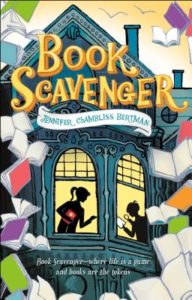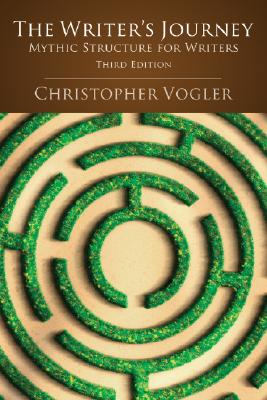craft review by Jen Jobart
 One of the reasons that Book Scavenger by Jennifer Chambliss Bertman is such an intriguing read is that its cast of engaging characters expresses common archetypes–the character roles that universally populate stories. Bertram’s novel follows twelve-year-old Emily, new to San Francisco, as she follows clues in a mysterious book that might just be the new Book Scavenger game designed by her hero, Garrison Griswold. But Griswold has been attacked and is in a coma. Emily and her new friend James work together to solve the puzzle before whoever attacked Griswold comes after them. Each of these characters from Book Scavenger, and additional characters, fit the roles of the archetypes. Bertram provides a master class in archetypes and what makes them work.
One of the reasons that Book Scavenger by Jennifer Chambliss Bertman is such an intriguing read is that its cast of engaging characters expresses common archetypes–the character roles that universally populate stories. Bertram’s novel follows twelve-year-old Emily, new to San Francisco, as she follows clues in a mysterious book that might just be the new Book Scavenger game designed by her hero, Garrison Griswold. But Griswold has been attacked and is in a coma. Emily and her new friend James work together to solve the puzzle before whoever attacked Griswold comes after them. Each of these characters from Book Scavenger, and additional characters, fit the roles of the archetypes. Bertram provides a master class in archetypes and what makes them work.
Why archetypes?
In story, an archetype is the role that a particular character or story element plays. An archetype can be expressed in many ways: by a human of any age or gender or race, an animal, or an imaginary creature, just to name a few examples. An archetype doesn’t even have to be a character. For example, the puzzle and the computer program in Book Scavenger fill the roles of two archetypes.
As Christopher Vogler writes in his book The Writer’s Journey, “The concept of archetypes is an indispensable tool for understanding the purpose or function of characters in a story. If you grasp the function of the archetype which a particular character is expressing, it can help you determine if the character is pulling her full weight in the story. The archetypes are part of the universal language of storytelling, and a command of their energy is as essential to the writers as breathing.”
Archetypes are based not only in story, but also in the universal human experience. As Vogler writes in his book, “[Psychologist Carl G. Jung] noticed a strong correspondence between his patients’ dream figures and the common archetypes of mythology. He suggested that both were coming from a deeper source, in the collective unconscious of the human race.”
Most of us are the Hero of our own lives and have a supporting cast in our lives comprised of all of the archetypes. These themes run deeply through the human experience. Using them wisely is a key way to make our stories feel more realistic.
Studying archetypes has changed my own writing. By identifying archetypes in my story, I figure out how to strengthen the conflicts as I revise. In researching this blog post, I realized that I’d chosen the wrong character to be the Shadow in the novel I’m currently writing. Understanding the role of the Shadow archetype, and selecting a more appropriate character to play it, made my book’s external plot and main character’s growth path stronger.
My hope for you is that by the end of this post, you will be able to start to identify how you’re using the archetypes in your own story, and think about whether there are ways that you can make your cast of characters even stronger.
Book Scavenger Archetypes
Book Scavenger makes a good case study for archetypes. The characters are fairly easy to identify, and Bertman uses them in a creative way that shows the many possibilities of archetypes and the ways that we can play with them to create a strong story.
Hero
 The Hero has two major roles in a story. First, the Hero gives the reader a window into the plot. This correlates with the “Outer Journey,” also known as the external plot. The Hero is also the character who most grows and changes over the course of the story. This correlates to the “Inner Journey,” or internal plot. You may know the Hero by its other name, the protagonist.
The Hero has two major roles in a story. First, the Hero gives the reader a window into the plot. This correlates with the “Outer Journey,” also known as the external plot. The Hero is also the character who most grows and changes over the course of the story. This correlates to the “Inner Journey,” or internal plot. You may know the Hero by its other name, the protagonist.
In Book Scavenger, Emily is our Hero. The book is mostly written in the third person limited point of view, from Emily’s perspective. The main external plot and internal plots center around her. Emily is the reader’s window into the Book Scavenger mystery.
Shadow
No story would be complete without an antagonist. The Shadow is that character.
In Book Scavenger, Barry and Clyde play the role of Shadow. They are introduced right away in Chapter 1, when Bertman shows how they are so intent on winning the Gold-Bug puzzle that they shoot Mr. Griswold. Throughout the story, Barry and Clyde vie with Emily to see who will solve the puzzle first.
Mr. Remora is the force behind Barry and Clyde, but since he’s more distant from Emily, he’s a less relevant Shadow.
Ally
An Ally is the Hero’s friend or supporting cast. An Ally humanizes the hero, reveals additional dimensions of her personality, and challenges the Hero to embrace her growth path. A story can have multiple Allies.
At the beginning of Book Scavenger, our hearts break a little for Emily when we learn that, because she’s moved so often, she hasn’t made any long-term friends. But then, when Emily moves to San Francisco, James swoops in right away and helps Emily solve her first puzzle when he sees something that Emily overlooks. He tells her, “It’s easy to miss stuff like that. That’s why two eyes are better than one.” James is Emily’s partner and support and is by her side, helping her solve the mystery.
Book Scavenger, like many books, has a main plot and also supporting plots, or “B Stories.” Emily’s and James’s evolving friendship is one of the B Stories in Book Scavenger. For a while, their friendship falls apart, as Emily struggles to understand what it is to be a friend. During this part of the book, especially, Emily’s brother Matthew steps in as another Ally.
Mentor
A Mentor is an older or wiser character who helps the Hero and provides critical advice. All of us have had mentors in our lives, be they parents, teachers, or helpful friends.
Hollister is the Mentor in Book Scavenger. Without his help, Emily wouldn’t be able to solve the mystery. He helps her understand what makes her copy of Gold Bug special, and he swoops in to protect her from the bad guys when she finds herself in over her head. He doesn’t live the plot for her, but he helps her during critical moments of the story.
Raven, the computer program that gives hints about the mystery, also plays the role of Mentor. Whenever Emily feels she’s well and truly stuck, Raven gives her a tiny bit of guidance that moves her forward. And note, here, that the archetype doesn’t even have to be a person.
Threshold Guardian
The Threshold Guardian’s main role in a story is to test the Hero. This test provides the jumping-off point for both the external and internal journeys.
Continuing along with our trend of an archetype not even being a character, the puzzle itself serves as the Threshold Guardian. In solving it, Emily pushes herself to become more proficient at puzzles and to become a better friend to James.
Herald
A Herald delivers the call to adventure that catapults the Hero from her normal everyday life into the story.
Mr. Griswold is the herald in Book Scavenger. Even though Mr. Griswold is largely absent for much of the story, the challenge that he sets up drives much of the external plot.
Shapeshifter
In story, as in life, sometimes things are not as they seem. Although it seems as if another person has changed, the reality is that it’s often our perspective that has changed. That is why a Shapeshifter is so important in story. It is a tangible representation of the internal growth of our Hero.
In Book Scavenger, Mr. Quisling is one Shapeshifter. We’re never quite sure whether he’s on Emily’s side or not. He seems to be against her when he shames her for note passing in the classroom, but then his commentary evolves into a puzzle challenge that plays off Emily’s strengths and ultimately strengthens her friendship with James. He seems to be an ally when Emily realizes that he’s Babbage, but then it turns out that he wants to solve the puzzle himself. We can’t quite pin him down.
Matthew is another. At first, he seems rather distant, but then, as James fades out, Matthew sacrifices his own interest in connecting with the band that he loves to help Emily solve her puzzle. Emily’s interactions with Matthew show that sibling relationships can change over time–a timely and compelling message for a middle grade audience.
Want to learn more?
The archetypes were originally identified by Joseph Campbell in his book The Hero with a Thousand Faces. If you really want to understand where the idea of the Hero’s Journey comes from, there is no substitute for reading Campbell’s book. However, it was written for an academic audience and can be a bit difficult to follow.
Christopher Vogler condensed the concepts of Campbell’s book into a 7-page memo that he developed while working as a story consultant for Disney in the 1940s. This memo circulated through Disney like wildfire and soon formed the basis for what has become Vogler’s book, The Writer’s Journey: Mythic Structure for Writers. There are two complementary audio presentations narrated by Christopher Vogler: Using Myth to Power your Story, by Christopher Vogler, and The Hero’s 2 Journeys, by Michael Hauge and Christopher Vogler.
All of these resources are best known as guides for screenwriters, but the advice in them applies to all types of stories, including middle grade novels.
Action: How do you express the archetypes in the book you’re working on? Is there anything you could do differently to make sure your cast of characters supports your story in the strongest way possible?
Let us know in the comments.
Jen Jobart writes middle grade fiction and is always sending characters she loves on dangerous adventures. She is an active member of the SCBWI and has studied writing for children through Stanford’s Continuing Studies program. When Jen’s not writing, she’s outside gardening and raising chickens at her home in the San Francisco Bay Area. Find her at www.jenjobart.com.


Thanks Jen.
I found this post very helpful. It gives me better insight into the characters in my latest story and how I can enhance each character’s persona to better define their role in the story.